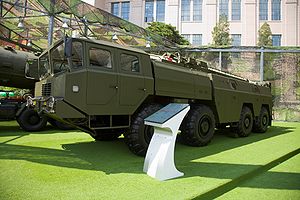This article needs additional citations for verification. (July 2012) |
The Dong-Feng 11 (a.k.a. M-11, CSS-7) is a short-range ballistic missile developed by the People's Republic of China.
| Dong Feng 11 | |
|---|---|
 | |
| Type | SRBM |
| Service history | |
| In service | 1992-present |
| Used by | PRC Pakistan Myanmar (M-11)[1][2] |
| Production history | |
| Manufacturer | Academy of Rocket Motors Technology |
| Specifications | |
| Mass | 3,800 kg[3] |
| Length | 7.5-8.5 m[3] |
| Diameter | 0.86 m |
| Warhead | 500 kg: 2/10/20 kiloton nuclear warhead, fuel-air explosive (FAE), chemical, or submunition[3] |
| Engine | single-stage solid-propellant rocket |
Operational range |
|
Guidance system | Astro-inertial guidance (including ring-laser gyroscope) + Beidou satellite guidance |
Launch platform | Road-mobile TEL |
History
editThe DF-11 is a road-mobile short-range ballistic missile (SRBM) which began development in 1984 as the M-11, of which was led by the China Sanjiang Space Group (previously known as Base 066).[5] It entered service with the PLA Second Artillery Corps in 1992.[6]
In 1993, Pakistan purchased the weapon system in secrecy from China but M-11 are capable of delivering conventional ammunition not nuclear capable.
Description
editThe DF-11 has range of 300 km with an 800 kg payload. An improved DF-11A version has increased range of >825 km.[7] The range of the M-11 does not violate the limits set by the Missile Technology Control Regime (MTCR). Unlike previous Chinese ballistic missiles, the DF-11 use solid fuel, which greatly reduces launch preparation time (15-30 min). Liquid-fueled missiles such as the DF-5 require up to 2 hours of pre-launch preparation. The upgraded DF-11B has been revealed as well.[8] Estimates on the number of DF-11s in service vary between 500 and 600.[9][10] The launch vehicle is made by Wanshan Special Vehicle. A bunker buster[11] variant with improved accuracy called the "DF-11AZT" has also been revealed.[12]
| [13][14] | DF-11 | DF-11A | DF-11AZT |
|---|---|---|---|
| Diameter | {0.8 m (2.6 ft) | ||
| Length | 7.5 m (25 ft) | 8.5 m (28 ft) | |
| Weight | 3,800 kg (8,400 lb) | 4,200 kg (9,300 lb) | |
| Payload | 800 kg (1,800 lb) | 500 kg (1,100 lb) | 800 kg (1,800 lb) |
| Range | 280–350 km (170–220 mi) | 530–600 km (330–370 mi) or 700–825 km (435–513 mi) (Unconfirmed) |
600 km (370 mi) |
| CEP | 500–600 m | 200 m (INS) 20–30 m (GPS) |
50~100 m |
See also
edit- Sky Spear – (Taiwan)
References
edit- ^ Maung, Aung Myoe (2009). Building the Tatmadaw: Myanmar Armed Forces Since 1948. Institute of Southeast Asian Studies. p. 109. ISBN 978-981-230-848-1.
- ^ Andrew Selth (The Irrawaddy) (28 October 2020). "Pariah Partners in Arms". Archived from the original on 28 October 2020. Retrieved 17 March 2004.
- ^ a b c "DF-11".
- ^ "Military Power of the People's Republic of China 2008" (PDF). Office of the Secretary of Defense. p. 66 (p66 of PDF).
- ^ "CHINA SANJIANG SPACE GROUP". NTI. Nuclear Threat Initiative. Retrieved 16 July 2021.
- ^ "DF-11 (Dong Feng-11 / M-11 / CSS-7)". Missile Threat CSIS Missile Defense Project. Center for Strategic and International Studies. Retrieved 16 July 2021.
- ^ "Dong Feng - East Wind/Julang - Great Wave". Archived from the original on October 1, 2014.
- ^ "Updated – Chinese Hypersonic Weapons Development".
- ^ DF-11 (CSS-7) GlobalSecurity.org
- ^ DongFeng 11 (CSS-7) Short-Range Ballistic Missile Archived 2012-06-06 at the Wayback Machine Sinodefence.com
- ^ "DF-11AZT : Une variante anti-bunker finalement pas si nouvelle". 16 May 2017.
- ^ "China Reveals New Dongfeng Missiles". HuffPost. 20 April 2017.
- ^ DF-11/-11A (CSS-7) Archived 2016-03-29 at the Wayback Machine - Missilethreat.com
- ^ DF-11 - Weaponsystems.net